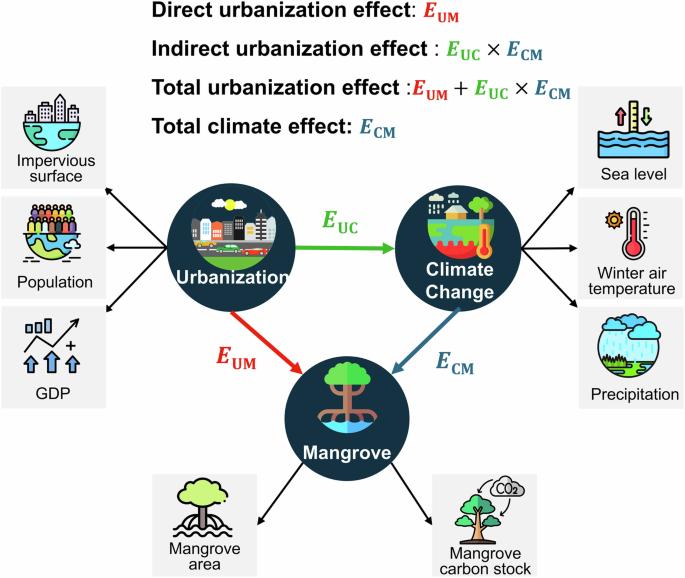Coastal urbanization may indirectly positively impact growth of mangrove forests
IF 8.1
1区 地球科学
Q1 ENVIRONMENTAL SCIENCES
引用次数: 0
Abstract
Coastal urbanization is a key driver of mangrove loss, yet its global impacts on mangroves have yet to be thoroughly understood. Here we present a fine-scale assessment of the hidden impacts of urbanization on mangroves mediated by climate, and the joint effects of urbanization and climate at the global scale. Surprisingly, both urbanization and climate had positive impacts on mangrove growth and carbon stock in some regions, which is different from the general belief of the adverse impacts from previous research. In total, 27.3% of global mangroves received positive impacts from urbanization regarding their extent and carbon stock, among which 59.5% are indirectly mediated by climate. Moreover, mangroves in subtropical/temperate climate zones experienced more indirect positive impacts from urbanization, which enhances local climate conditions for growth by altering temperature, rainfall and sea levels. These findings suggest the feasibility of facilitating mangrove conservation through effective urban planning to achieve coastal sustainability. Mangroves may indirectly benefit from coastal urbanization in some areas due to more favorable local climatic conditions for growth, according to modeling of urbanization, climate, and mangrove growth causal relationships.

沿海城市化可能间接对红树林的生长产生积极影响
沿海城市化是红树林消失的主要驱动因素,但其对红树林的全球影响仍有待深入了解。在此,我们对以气候为媒介的城市化对红树林的隐性影响,以及城市化和气候在全球范围内的共同影响进行了精细评估。令人惊讶的是,在一些地区,城市化和气候对红树林的生长和碳储量都有积极影响,这与以往研究普遍认为的不利影响不同。全球共有 27.3% 的红树林在其范围和碳储量方面受到城市化的积极影响,其中 59.5% 间接受到气候的影响。此外,亚热带/温带气候区的红树林受到城市化的间接积极影响更大,城市化通过改变温度、降雨量和海平面,改善了当地生长的气候条件。这些研究结果表明,通过有效的城市规划促进红树林保护以实现沿海地区的可持续发展是可行的。根据对城市化、气候和红树林生长因果关系的建模,在某些地区,由于当地气候条件更有利于红树林的生长,红树林可能间接受益于沿海城市化。
本文章由计算机程序翻译,如有差异,请以英文原文为准。
求助全文
约1分钟内获得全文
求助全文
来源期刊

Communications Earth & Environment
Earth and Planetary Sciences-General Earth and Planetary Sciences
CiteScore
8.60
自引率
2.50%
发文量
269
审稿时长
26 weeks
期刊介绍:
Communications Earth & Environment is an open access journal from Nature Portfolio publishing high-quality research, reviews and commentary in all areas of the Earth, environmental and planetary sciences. Research papers published by the journal represent significant advances that bring new insight to a specialized area in Earth science, planetary science or environmental science.
Communications Earth & Environment has a 2-year impact factor of 7.9 (2022 Journal Citation Reports®). Articles published in the journal in 2022 were downloaded 1,412,858 times. Median time from submission to the first editorial decision is 8 days.
 求助内容:
求助内容: 应助结果提醒方式:
应助结果提醒方式:


